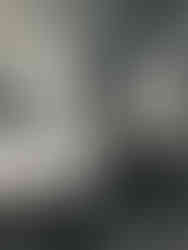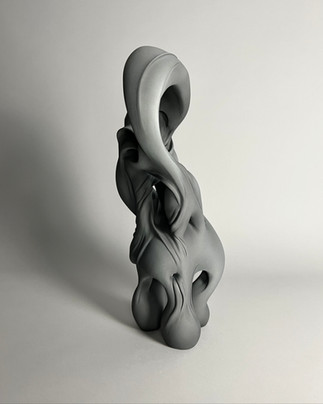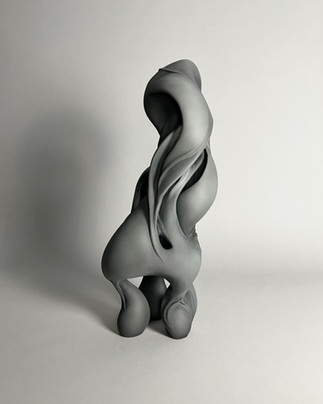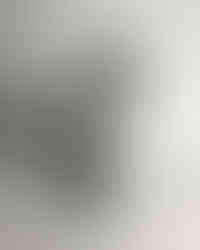Shaping Stillness: Inside the Practice of Contemporary Sculptor Juliette Mangenot
- Selfless Art Gallery

- Jun 30
- 4 min read
Updated: Jul 20
In March 2025, contemporary sculptor Juliette Mangenot partnered with Selfless Art Gallery to offer an intimate window into her creative practice. Through this collaboration, we step into the studio with her—into the stillness, uncertainty, and quiet revelations that define the emotional terrain of making art. From March 18 to April 4, Juliette focused on a single sculpture—built entirely from recycled clay. What began without direction, simply with a need to shape and feel, gradually evolved into something layered, intentional, and whole.
Working from a blank space—without sketches or plans—Juliette approached the sculpture with only the desire to move her hands and engage in dialogue with the material. What followed was a slow unfolding. With each studio visit, the piece deepened—not just in structure, but in emotional resonance. It transformed alongside her, shaped by moments of frustration, stillness, breakthrough, and reflection. At Selfless Art, we believe the journey is equally important—if not more important—than the final piece. It is within the act of making, the unseen shifts and intimate struggles, where meaning is forged and presence is cultivated. Juliette’s process exemplifies this truth—where the evolution of the work mirrors the evolution of the self.
Phase One: The Uncertain Beginning The process didn’t begin with a design. There was no final form in mind. Instead, Juliette entered the studio with a quiet urge—to touch, to shape, to listen. Over several days, she returned to the same corner, engaging with the clay not as a task but as a conversation. The sculpture rose slowly, hesitantly, as if unsure of its own direction. In these early sessions, the studio held a different kind of silence—one filled with questions. Juliette resisted the pressure to define or justify the piece too soon. The goal was simply to be present, to let the material lead.
“I felt more like I was asking the clay questions than trying to form it into anything definitive.”
What emerged during this time wasn’t just physical structure. It was the beginning of emotional groundwork—a space where uncertainty was allowed, even welcomed.
Phase Two: Friction and Form
Midway through the first couple of weeks, the sculpture began to reveal more of itself—but with that clarity came resistance. The clay, once pliable and quiet, began pushing back. For days, nothing seemed to align. Juliette questioned whether the piece was worth continuing. The weight of doubt settled in the room. But it was within this tension that the breakthrough began. Rather than force the clay to comply, she began cutting into it and removing sections that no longer felt honest. The process became more physical, more deliberate. Each incision carried intention. Through subtraction, form was clarified.
“It’s the moment I stopped trying to make it perfect that things began to breathe.”
This was a turning point—not in the sculpture’s appearance, but in Juliette’s approach. The work was no longer about chasing an outcome. It was about finding truth in friction.
Phase Three: Surrender and Trust
As March came to a close, the pace slowed. Juliette re-entered the studio with a softer touch. The urgency had lifted. Now, the work felt like a quiet return—a rhythm she could trust. She stopped needing to solve the sculpture. Instead, she began listening to its silence. These days were marked by subtle shifts: smoothing edges, deepening texture, stepping back more than stepping in. There was a noticeable change—not just in the form, but in the energy of the studio. It became a place of release.
“Somewhere along the way, I realized the piece wasn’t trying to be anything but honest.”
Here, surrender was not a retreat, but an act of creative confidence. The piece began to feel less like something being made and more like something being met.
Phase Four: Integration and Reflection
In early April, the sculpture entered a stage of cohesion. Juliette returned to it with a calm sense of direction. Now, it was about bringing the parts into conversation—integrating what had emerged during previous phases. Transitions became smoother. Edges softened. Surfaces were unified, yet still held the memory of earlier tension. The studio transformed into a reflective space. Juliette wasn’t just shaping clay; she was engaging with the full emotional arc of the work. Each mark carried traces of earlier decisions. Each curve held the echo of a previous hesitation.
“I could see the days in the layers. There’s something sacred about that.”
Every surface had become a page in an unspoken journal—ridges revealing rushed days, smoothness signaling calm. The sculpture evolved into a quiet archive of time, energy, and emotion. This phase was not about correction, but recognition. The final refinements were approached with care, not to erase imperfections, but to honor the journey already embedded within the form. The work now stood as a layered record—not only of artistic decisions, but of emotional time.
Phase Five: The Work Stands Alone
As the sculpture reached its final form, Juliette stepped back. With the clay drying and the structure complete, the energy in the studio shifted—from making to witnessing. No longer in dialogue with the material, she allowed the piece to exist on its own terms. It no longer needed her intervention; it simply stood, holding the story of its becoming. This moment of quiet distance was profound—not because the work was “done,” but because it had gained a kind of independence. The act of letting go was not a conclusion, but a recognition that the sculpture had arrived.
“It’s not perfect, but I’m stopping.”
The Reveal: Awakening
The final piece, titled Awakening, now stands as a quiet yet powerful embodiment of this entire journey. Sculpted through moments of hesitation, courage, release, and trust, Awakening is more than a finished work—it is a culmination of presence. Its form holds echoes of every phase, every shift, every silence. In revealing it, we are not simply unveiling an object, but honoring the invisible labor behind it: the emotional risks, the daily returns to uncertainty, the deep listening required to let something real emerge.
“It’s no longer mine. It belongs to the time, the space, and whoever meets it next.”
With this closing statement, Juliette captures the quiet power of knowing when to let go. Awakening is not about perfection—it is about presence. And in that presence, the work finds its own life.

To see more of Juliette's incredible work and stay updated on her latest projects, be sure to follow her on Instagram and visit her website.






















































Comments